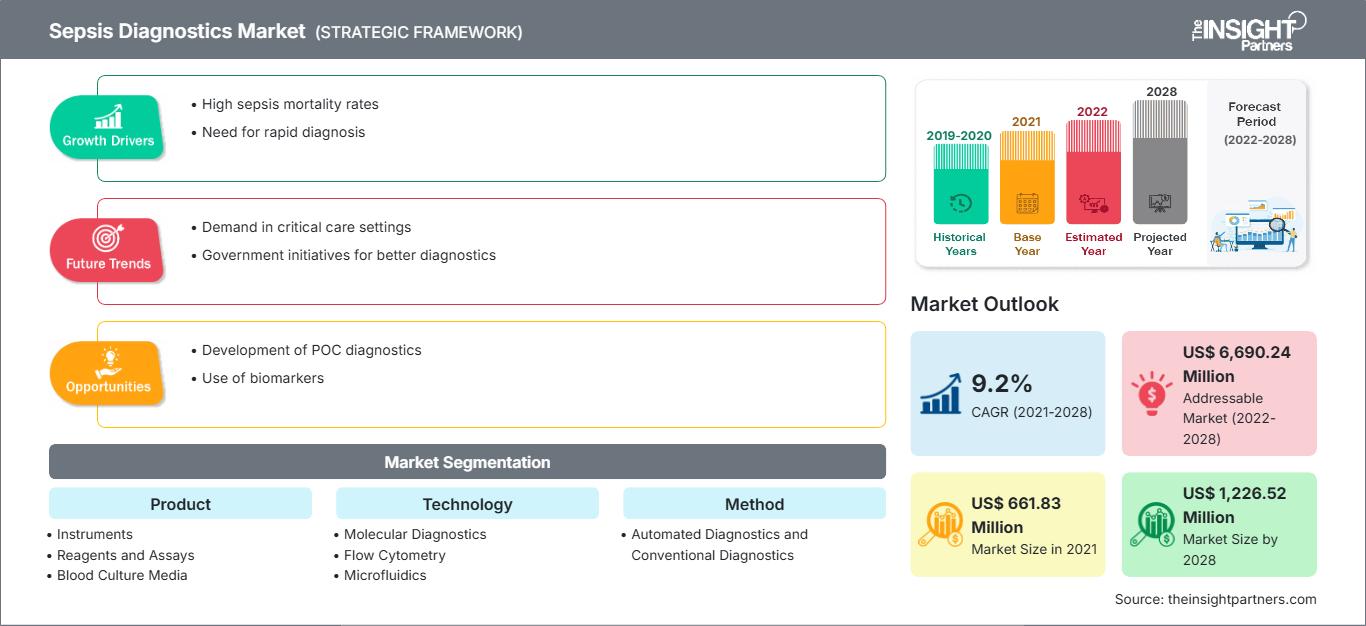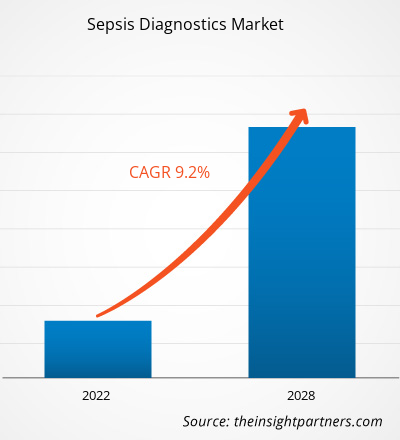Si prevede che il mercato della diagnostica della sepsi raggiungerà 1.226,52 milioni di dollari entro il 2028, rispetto ai 661,83 milioni di dollari del 2021; si prevede una crescita a un CAGR del 9,2% dal 2021 al 2028.
Fattori come l'aumento dell'incidenza della sepsi dovuto all'aumento delle infezioni nosocomiali e la crescente domanda di test diagnostici rapidi, che porta a un aumento dei lanci di prodotti, guidano la crescita del mercato della diagnostica della sepsi.
La sepsi è una condizione clinica grave e potenzialmente letale che generalmente deriva da un'infezione batterica primaria o, meno frequentemente, da un'infezione fungina e/o virale. Le tre fasi della sepsi sono la sepsi, la sepsi grave e la fase finale dello shock settico. La diagnostica della sepsi è lo studio della diagnosi di questa condizione.
È probabile che il Nord America domini il mercato della diagnostica della sepsi durante il periodo di previsione. Gli Stati Uniti hanno detenuto la quota maggiore del mercato nordamericano nel 2021 e si prevede che questa tendenza continuerà nel periodo di previsione. La sepsi colpisce una significativa popolazione di pazienti ospedalizzati ed è la sesta causa di ricovero ospedaliero. Si prevede che la crescente prevalenza della sepsi e l'aumento degli investimenti nella ricerca e nello sviluppo di soluzioni diagnostiche per la sepsi accelereranno la crescita del mercato della diagnostica per la sepsi nella regione. Inoltre, la presenza di grandi operatori del mercato sanitario si traduce in un aumento del lancio di prodotti per la diagnostica per la sepsi.
Personalizza questo rapporto in base alle tue esigenze
Potrai personalizzare gratuitamente qualsiasi rapporto, comprese parti di questo rapporto, o analisi a livello di paese, pacchetto dati Excel, oltre a usufruire di grandi offerte e sconti per start-up e università
Mercato della diagnostica della sepsi: Approfondimenti strategici

-
Ottieni le principali tendenze chiave del mercato di questo rapporto.Questo campione GRATUITO includerà l'analisi dei dati, che vanno dalle tendenze di mercato alle stime e alle previsioni.
Il mercato della diagnostica della sepsi è segmentato in base a prodotto, tecnologia, metodo, tipo di test, agente patogeno, utente finale e area geografica. Per area geografica, il mercato è ampiamente segmentato in Nord America, Europa, Asia-Pacifico, Medio Oriente e Africa e America meridionale e centrale. Il rapporto sulla diagnostica della sepsi offre approfondimenti e analisi approfondite del mercato, evidenziando parametri quali tendenze di mercato, progressi tecnologici, dinamiche di mercato e analisi competitiva dei principali attori del mercato a livello globale.
Approfondimenti di mercato
Elevata incidenza di sepsi dovuta all'aumento delle infezioni nosocomiali
La sepsi si verifica principalmente in soggetti immunodepressi, come coloro che assumono chemioterapia, sono stati sottoposti a splenectomia e soffrono di AIDS e malattie croniche come il diabete. Le infezioni nosocomiali, note anche come infezioni nosocomiali, sono la principale causa di morbilità e mortalità tra i pazienti ricoverati. Secondo il "2020 National and State Healthcare-Associated Infections Progress Report" pubblicato dai Centers for Disease Control and Prevention (CDC) nel 2021, negli Stati Uniti tra il 2019 e il 2020 si è registrato un aumento rispettivamente del 24%, 35% e 15% delle infezioni del torrente ematico associate all'inserimento di catetere venoso centrale, degli eventi associati alla ventilazione e della batteriemia da Staphylococcus aureus resistente alla meticillina (MRSA). Pertanto, l'aumento delle infezioni del torrente ematico aumenterà l'adozione di prodotti diagnostici per la sepsi.
A settembre 2020, l'Organizzazione Mondiale della Sanità (OMS) ha stimato che ogni anno quasi il 50% dei casi di sepsi si verifica tra i bambini e che 2,9 milioni di decessi si sono verificati in età pediatrica. La maggior parte dei decessi può essere prevenuta attraverso una diagnosi precoce e un'adeguata gestione clinica. Pertanto, l'elevato tasso di incidenza della sepsi aumenta la domanda di prodotti diagnostici per la sepsi, sostenendo così la crescita del mercato della diagnostica per la sepsi.
Approfondimenti sui prodotti
In base al prodotto, il mercato globale della diagnostica per la sepsi è segmentato in strumenti, reagenti e test, terreni di coltura per emocoltura e software. Nel 2021, il segmento dei terreni di coltura per emocoltura ha detenuto la quota maggiore del mercato. Secondo il rapporto del Journal of the Academy of Clinical Microbiologists, i terreni di coltura per emocoltura rimangono una delle indagini più critiche nella gestione della sepsi, in quanto consentono l'identificazione dell'organismo responsabile della sepsi, la scelta appropriata di antibiotici empirici e specifici e indicano la necessità di ulteriori indagini per identificare il focolaio dell'infezione. Si raccomanda l'uso di terreni di coltura per emocoltura per tutti i pazienti settici. Tuttavia, si prevede che il segmento del software registrerà il CAGR più elevato sul mercato durante il periodo di previsione.
Approfondimenti tecnologici
In base alla tecnologia, il mercato globale della diagnostica della sepsi è segmentato in diagnostica molecolare, citometria a flusso, microfluidica, immunoanalisi, biomarcatori e microbiologia. Nel 2021, il segmento della microbiologia ha detenuto la quota di mercato maggiore. L'identificazione rapida e specifica dei patogeni è importante per il trattamento della sepsi e le tecniche microbiologiche rappresentano il gold standard per l'identificazione dei patogeni della sepsi, che può essere effettuata tramite emocoltura seguita da subcoltura e identificazione dei patogeni con mezzi biochimici o microscopici. Tuttavia, si prevede che il segmento della diagnostica molecolare registrerà il CAGR più elevato sul mercato durante il periodo di previsione.
Approfondimenti metodologici
In base al metodo, il mercato globale della diagnostica della sepsi è suddiviso in diagnostica automatizzata e diagnostica convenzionale. Nel 2021, il segmento della diagnostica convenzionale ha detenuto una quota di mercato maggiore. Tuttavia, si prevede che il segmento della diagnostica automatizzata registrerà un CAGR più elevato sul mercato durante il periodo di previsione. La procedura diagnostica convenzionale per la sepsi richiede alcuni giorni. Pertanto, il metodo diagnostico convenzionale viene adottato lentamente rispetto alla diagnostica automatizzata. Inoltre, le aziende si concentrano sullo sviluppo di diagnostica automatizzata basata su tecnologie avanzate, come la diagnostica molecolare per la rilevazione della sepsi.
Approfondimenti sulla tipologia di test
In base alla tipologia di test, il mercato globale della diagnostica della sepsi è segmentato in test point-of-care e test di laboratorio. Nel 2021, il segmento dei test di laboratorio deteneva una quota di mercato maggiore. Tuttavia, si prevede che il segmento dei test point-of-care registrerà un CAGR più elevato sul mercato durante il periodo di previsione. Le piattaforme POC possono portare a un intervento tempestivo con terapie appropriate, semplificando le esigenze del processo diagnostico e offrendo informazioni cliniche accessibili e convenienti per rilevare la sepsi in una fase molto più precoce.
Approfondimenti sui patogeni
In base al patogeno, il mercato globale della diagnostica della sepsi è segmentato in sepsi batterica, sepsi fungina e altre. Nel 2021, il segmento della sepsi batterica ha detenuto la quota di mercato maggiore. Inoltre, si prevede che lo stesso segmento registrerà il CAGR più elevato sul mercato durante il periodo di previsione.
Approfondimenti sugli utenti finali
In base all'utente finale, il mercato globale della diagnostica della sepsi è segmentato in ospedali, laboratori di patologia e di riferimento e altre. Nel 2021, il segmento degli ospedali ha detenuto la quota di mercato maggiore. Tuttavia, si prevede che il segmento dei laboratori di patologia e di riferimento registrerà il CAGR più elevato del mercato durante il periodo di previsione.
Il lancio di prodotti e le collaborazioni sono strategie ampiamente adottate dagli operatori del mercato globale della diagnostica della sepsi per espandere la propria presenza e il proprio portafoglio prodotti. Gli operatori si concentrano anche sulla strategia di partnership per ampliare la propria clientela, il che, a sua volta, consente loro di mantenere il proprio marchio a livello globale. Il loro obiettivo è quello di incrementare le proprie quote di mercato con lo sviluppo di prodotti innovativi. Di seguito sono elencati alcuni dei recenti sviluppi chiave del mercato:
- A novembre 2021, T2Biosystems, Inc. ha stipulato un accordo di distribuzione esclusiva territoriale a Taiwan. In base ai termini dell'accordo, T2 Biosystems venderà gli strumenti T2Dx, insieme ai pannelli T2Bacteria, T2Candida e T2Resistance tramite il proprio distributore. T2 Biosystems e il suo nuovo partner di distribuzione collaborano con le autorità sanitarie di Taiwan per ottenere l'approvazione normativa e offrire ai pazienti la massima qualità di assistenza per la sepsi.
- A maggio 2019, Beckman Coulter, sussidiaria di Danaher, ha lanciato il test Access PCT. La sensibilità all'avanguardia e la precisione di fascia bassa del test Access PCT, combinate con un breve tempo di incubazione, aiutano i medici nella valutazione del rischio di pazienti critici a rischio di progressione verso sepsi grave o shock settico, con risultati disponibili in meno di 20 minuti. Il nuovo test Access PCT ha ottenuto la certificazione CE ed è disponibile per l'uso sulla famiglia di sistemi di immunodosaggio Access, inclusi Access 2, UniCel DxI 600 e UniCel DxI 800.
Approfondimenti regionali sul mercato della diagnostica della sepsi
Le tendenze regionali e i fattori che influenzano il mercato della diagnostica della sepsi durante il periodo di previsione sono stati ampiamente spiegati dagli analisti di The Insight Partners. Questa sezione illustra anche i segmenti e la geografia del mercato della diagnostica della sepsi in Nord America, Europa, Asia-Pacifico, Medio Oriente e Africa, America Meridionale e Centrale.
Ambito del rapporto di mercato sulla diagnostica della sepsi
| Attributo del rapporto | Dettagli |
|---|---|
| Dimensioni del mercato in 2021 | US$ 661.83 Million |
| Dimensioni del mercato per 2028 | US$ 1,226.52 Million |
| CAGR globale (2021 - 2028) | 9.2% |
| Dati storici | 2019-2020 |
| Periodo di previsione | 2022-2028 |
| Segmenti coperti |
By Prodotto
|
| Regioni e paesi coperti |
Nord America
|
| Leader di mercato e profili aziendali chiave |
|
Densità degli operatori del mercato della diagnostica della sepsi: comprendere il suo impatto sulle dinamiche aziendali
Il mercato della diagnostica della sepsi è in rapida crescita, trainato dalla crescente domanda degli utenti finali, dovuta a fattori quali l'evoluzione delle preferenze dei consumatori, i progressi tecnologici e una maggiore consapevolezza dei benefici dei prodotti. Con l'aumento della domanda, le aziende stanno ampliando la propria offerta, innovando per soddisfare le esigenze dei consumatori e sfruttando le tendenze emergenti, alimentando ulteriormente la crescita del mercato.

- Ottieni il Mercato della diagnostica della sepsi Panoramica dei principali attori chiave
Diagnostica della sepsi: segmentazione del mercato
Il mercato globale della diagnostica della sepsi è segmentato in base a prodotto, tecnologia, metodo, tipo di test, agente patogeno e utente finale. In termini di prodotto, il mercato globale della diagnostica della sepsi è segmentato in strumenti, reagenti e test, terreni di coltura per emocoltura e software. In termini di tecnologia, il mercato della diagnostica della sepsi è segmentato in diagnostica molecolare, citometria a flusso, microfluidica, immunoanalisi, biomarcatori e microbiologia. In termini di metodo, il mercato è segmentato in diagnostica automatizzata e diagnostica convenzionale. In base al tipo di test, il mercato globale della diagnostica della sepsi è segmentato in test point-of-care e test di laboratorio. In termini di agente patogeno, il mercato è segmentato in sepsi batterica, sepsi fungina e altri. In termini di utente finale, il mercato della diagnostica della sepsi è segmentato in ospedali, laboratori di patologia e di riferimento e altri.
Profilo aziendale
- Abbott
- F. HOFFMANN-LA ROCHE LTD.
- Immunexpress Inc.
- BD
- Danaher
- Luminex Corporation
- Thermo Fisher Scientific Inc.
- bioMerieux SA.
- T2 Biosystems, Inc.
- Axis-Shield Diagnostics Ltd.
- Analisi storica (2 anni), anno base, previsione (7 anni) con CAGR
- Analisi PEST e SWOT
- Valore/volume delle dimensioni del mercato - Globale, Regionale, Nazionale
- Industria e panorama competitivo
- Set di dati Excel
Report recenti
Testimonianze
Motivo dell'acquisto
- Processo decisionale informato
- Comprensione delle dinamiche di mercato
- Analisi competitiva
- Analisi dei clienti
- Previsioni di mercato
- Mitigazione del rischio
- Pianificazione strategica
- Giustificazione degli investimenti
- Identificazione dei mercati emergenti
- Miglioramento delle strategie di marketing
- Aumento dell'efficienza operativa
- Allineamento alle tendenze normative






















 Ottieni un campione gratuito per - Mercato della diagnostica della sepsi
Ottieni un campione gratuito per - Mercato della diagnostica della sepsi